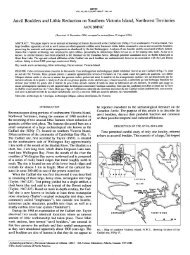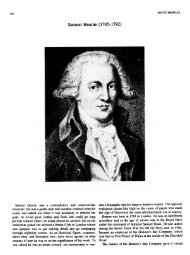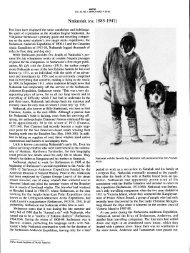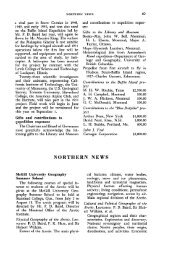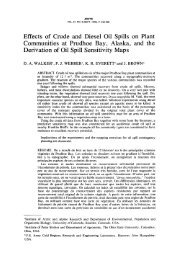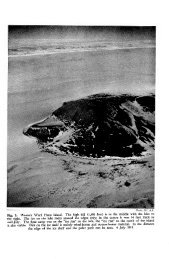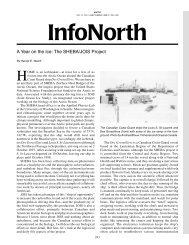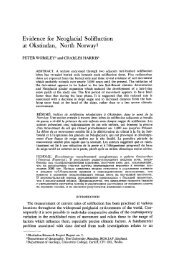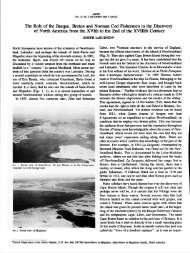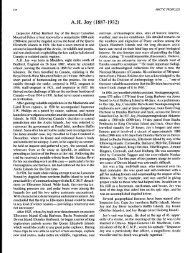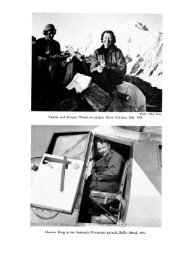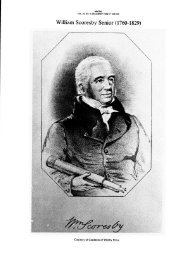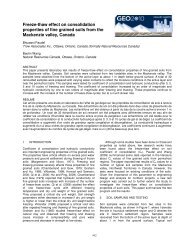NOTES ON THE NUNAMIUT ESKIMO AND MAMMALS OF ... - arctic
NOTES ON THE NUNAMIUT ESKIMO AND MAMMALS OF ... - arctic
NOTES ON THE NUNAMIUT ESKIMO AND MAMMALS OF ... - arctic
You also want an ePaper? Increase the reach of your titles
YUMPU automatically turns print PDFs into web optimized ePapers that Google loves.
188 <strong>THE</strong> <strong>NUNAMIUT</strong> <strong>ESKIMO</strong> <strong>AND</strong> <strong>MAMMALS</strong> <strong>OF</strong> <strong>THE</strong> ANAKTUVUK PASS REGI<strong>ON</strong><br />
the old bulls, with an admixture of younger ones, come last. By April 1 the<br />
cows have ordinarily passed through to the Arctic<br />
are born.<br />
Slope, where the calves<br />
From early June until mid-summer, caribou are usually absent from the<br />
main valley, but in early August (August 9 in 1949) a second northward<br />
migration may be seen. The herds are of mixed sex and age and are variable in<br />
size, but the majority number less than 200 animals. Few observations on herd<br />
composition were made; the following examples, however, are ,representative:<br />
(1) 20 September 1949 (2) 20 September 1949 (3) 23 September 1949<br />
Old bulls 1 Old bulls 3 Old bulls 13<br />
Adult 0 4 Adult 0 5 Adult 0 0 10<br />
2-year-old 8 8 2 Yearlings 2 2-year-old 8 8 6<br />
Yearling 9 9 2 Calves 3 Yearling 8 8 and<br />
Calves 2 young o o 8<br />
Calves 8 - __ -<br />
Total 11 13<br />
45<br />
During this movement the bulls clean the velvet from their antlers by rubbing<br />
them on willows and other small bushes.<br />
Beginning typically in October, the entire herd comes south through the<br />
main valley. The rut occurs in mid-October, and there is much fighting among<br />
the bulls. The migration lasts well into November. However, in 1949 the<br />
southward movement did not begin until December. By January 1950 the<br />
main movement was towards the south, but on January 31 I saw a herd of<br />
from 3,000 to 4,000 animals moving to the north.<br />
The following observations give some idea of the erratic nature of caribou<br />
movements:<br />
In the fall of 1949 large numbers of caribou came out of Publatuk Creek from the<br />
east, and went up the main valley as far as Nachramkunga Creek, and on to the west.<br />
In December they moved in large numbers east through Inukpasukruk Creek and<br />
went over the divide into the Savioyok valley. They then apparently went on<br />
south and came back into the main valley via the Publatuk. Many re-entered the<br />
main valley just below Kalutak Creek. Some also came out along the Okoluk, and<br />
some over the high mountains near the fork called Kayak, at the confluence of the<br />
Kalutagiak and the John rivers. This general movement persisted until the end of<br />
April 1950, when the animals again moved northward through the main valley. The<br />
northward movement in 1950 persisted in the main valley until the end of June;<br />
after that no caribou were seen, except for a few stragglers, until late November.<br />
There were northward migrations farther to the west, however, through the vallev<br />
of Chandler Lake, from the middle of August through September. Large herds were<br />
seen moving east, south of the Colville on the Arctic Slope. According to later<br />
information, it would seem that the main southward migration during the fall of 1950<br />
took place through the Chandalar drainage. The first caribou coming south reached<br />
the divide between the two drainages on November 10, and consisted mostly of<br />
males. About 2,000 animals, mostly females, were observed at Tulugak Lake on<br />
November 20. Another herd of more than 1,000 was seen on December 5. This<br />
southward migration continued into February 1951. During March caribou came<br />
north up the John River, and some also came north out of Inukpasukruk and<br />
Nachramkunga creeks. Not many caribou were seen in the main valley in early<br />
April. On April 23 about 500 animals,!mostly females, came north from Inukpasukruk<br />
Creek. From late spring until late September caribou were scarce. A few<br />
animals came from Anivik (from aniruk, “come out”) Creek during September and



